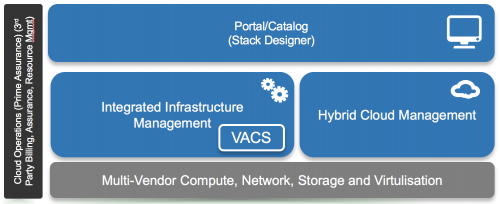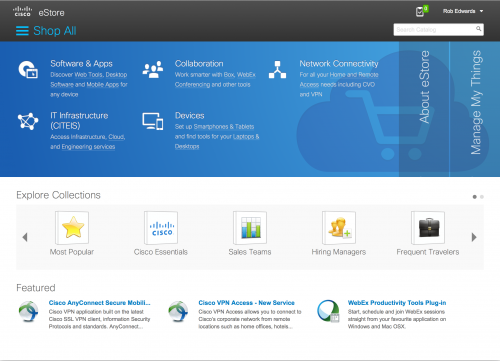This is a copy of the Cisco blog series written by me and published on cisco.com.

It’s nice to write a blog that will be seen by more than the handful who usually read my personal blog (I should probably advertise it a bit more!). I work within the data centre and cloud automation/orchestration space, therefore it won’t come as a surprise that this post is related to my day job. I originally had a long post however decided to break it down into smaller, consumable parts – as a result this is part one of three.
I think it’s safe to say that companies like Amazon, (others are available) have altered expectations on how we consume ‘things’. I’m talking about both the online store and their AWS cloud. As a direct result, whenever I order something, it doesn’t matter where from, I now expect my orders to be delivered quicker than ever. I also expect to have an easy user interface to interact with, ideally a single one that can serve all my consumer gratification needs. Many other examples exist in our day-to-day lives where we expect that ‘instant’ (or close to) gratification with ease of interaction (it’s an endless list);
- A tap on my device and I expect to get access to the music or films I want
- ‘Click and collect’ at stores
- Pre-order coffee via your phone whilst walking to the shop
- Order takeaways to be delivered to your door from a single aggregation catalogue
So it will come as no surprise that when people step into the work environment they have a level of expectation that they can easily and quickly obtain a reliable, consistent IT service (after all I can at home). That could be a single server; a project/development environment; a complete new bit of infrastructure; laptops or even applications.
If we look specifically at the data centre, and based on my experience of working for many years as an engineer/architect for customers before joining Cisco, I can confirm many organisations don’t achieve those sorts of expectations. In fact there is a good chance that interacting with the IT team involves raising multiple tickets; filling in spreadsheets; sending emails and waiting weeks to get what somebody thought you wanted!

As well as these demands on IT, business leaders are looking at how IT departments can help them succeed in a highly competitive world, where industries are being transformed by start-ups and competitors who can change and adapt quickly to the market. As a result IT departments are under new levels of scrutiny by the business and end-users to deliver services at speed whilst providing flexibility, consistency, compliance and security.
We, as Cisco, have a solution to help you on this new journey. So how can we help deliver this within today’s data centre and provide users with a cloud like experience?
- Comprehensively automate/orchestrate existing data centre
- Ability to expand into public cloud and have a hybrid cloud solution
- Self-service experience
- Accelerate application development and deployment
The solution put together to address these challenges is called Cisco Enterprise Cloud Suite (CECS).
To help achieve the above I like to break them down to smaller easier to solve Lego-type blocks, I suspect that’s because I played with a lot of Lego growing up! Typically we would use a number of Lego bricks to build the solution, as well as being able to grow and add extensions as required.

Whilst I don’t focus on the computer, network or storage aspects, it’s still a critical foundation that’s required for success. The infrastructure can either assist in building the solution or be its biggest downfall.
While some of these Lego bricks could be different colours (i.e. other vendors), what we have done is simplified how the blocks connect, and done lots of the integration work for you out of the box.

The top building block, that I have labelled as the portal/catalogue, is an easy and simple user interface (or Restful API if required) for ordering services and life-cycle management of the assets available to the end user. It allows seamless design and deployment of complete application stacks. As you would expect with a catalogue it is highly customisable allowing you to alter the look and feel as well as integrating with other tools that are not part of the suite.
The following three screen shots are examples of the same portal framework being customised;



The first screenshot is actually how we consume Cisco IT internally. It doesn’t just provide a front door into ordering and managing data centre resources, it also allows me to see what tools and applications I am using with options to amend or cancel them.
I believe that it’s important for a portal/catalog solution to have the ability to not only cover your initial needs, but also be expandable as requirements evolve. I have worked in organisations in the past that ended up having multiple portals/catalogs depending on what you wanted to consume which was extremely frustrating. While my focus in this post has been around the data centre and cloud, the portal we have used to make up this solution is not limited to just that space and can be expanded to cover much more. Some of other the key benefits we can provide are;
- Easy-to-use customisable interface
- Dashboards based on role and access
- Lifecycle management on role and access
- Policy-based controls and approvals
If this has whetted your appetite to do further investigation into the Cisco portal capabilities that we use as part of the CECS solution have a look here.
Watch out next week for my second post in this three part series. I will cover how we can help you design and deploy complete stacks orchestrating both the deployment of infrastructure and also applications that sit on top of it. I will also discuss the other building blocks.